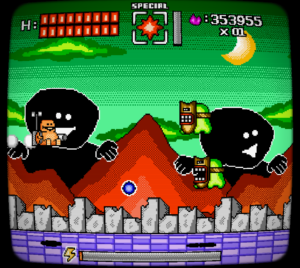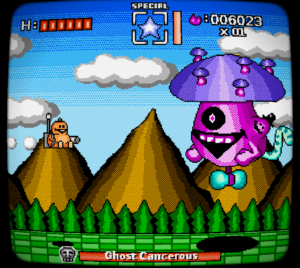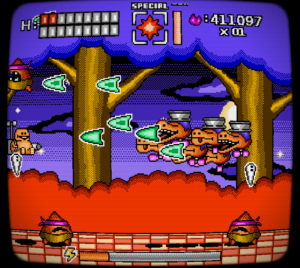Operation Fungus is a strange horizontal shmup with some rough edges and creative gameplay. There are only seven short stages, plus an eighth stage which is only a boss fight, but you’ll be seeing all of these stages multiple times as you cash in points after each defeat in order to upgrade various stats. This is not the first shmup to use points as a form of upgrade currency rather than as a way of tracking your score, but it is the only one I know of with its particular approach to stage progression and design.
Many of the systems in this game are closely tied to the point system. Killing an enemy awards points and creates a chain meter which gradually drains. Killing a second enemy while the chain meter is up will increase its multiplier, increasing the number of valuable points you receive, but taking too long to kill another enemy or taking any damage will immediately break the chain. Points are important for upgrading between attempts, but they are even more important for stage progression. Stages are designed to presumably go on forever and enemy patterns are somewhat randomized, though most of them start with a single enemy type and gradually throw anywhere from one to three other enemies into the mix as they progress.
The ultimate goal of each stage is to defeat its boss, but to actually make the boss appear in the first place you need to fill an energy meter at the bottom of the screen. How do you fill this meter? You fill it by getting more points, which accumulate faster the longer you can keep up a combo, which you can only keep up if you are strong enough to kill enemies quickly without taking damage. In addition to your combo resetting when you get hit, the energy meter itself is slightly reduced. Thus, the first few times you enter a stage you are likely just going to be trying to survive for as long as possible to gain more points, but you’ll soon be able to rapidly kill off anything which appears on the screen and summon the boss within about 30 seconds.

Upgrades obviously play an important role in Operation Fungus, but you have some important basic abilities too. Your basic attack comes in the standard form of a string of bullets, but they can be angled slightly upward or downward while you’re moving to make it easier to deal with many of the enemies without being directly in front of them. However, you also have a burst shot which needs to be charged up, but fires a chaotic spray of bullets across the screen. Most enemies stick around in the playfield until you kill them and, as even the weakest enemies generally can take three or more hits when you first reach a new stage, the screen can soon become flooded with foes if your basic attack can’t take them out quickly. This is where the burst shot really shines, especially if it has been upgraded to increase its bullet count, as it can deal with swarms of enemies much more effectively than your basic attack. There are also three special attacks which you can swap between at any time and which can be used after filling a meter from killing enemies. The laser special shoots directly in front of you and kills just about anything instantly, but it doesn’t last long, the lightning special sticks around and can kill enemies in just about any part of the screen, but it’s more difficult to use, and the star shield special is bound to the area around your character and doesn’t seem to actually ‘shield’ you from much of anything, but is easy to use and deals plenty of damage. The strengths and weaknesses of the specials are balanced well to each handle different situations, but you generally don’t get to use them until near the end of the stage and they don’t deal much damage to bosses.
Your last, and by far the most interesting, ability is to evade enemy attacks. With this, your character flies into the background, becoming unable to attack, but also briefly becoming able to fly across enemies and bullets. Normal enemies and bosses alike are capable of flooding the screen with walls of bullets which would usually be impossible to avoid, but the presence of the evade ability gives you the edge you need to survive against these onslaughts and gives Operation Fungus a unique feel. Many attacks also move very quickly or come in the form of a large, slow bullet which explodes into an unpredictable spread of smaller bullets, making it surprisingly important to pay attention to each enemy’s animations so you can preemptively evade before the attack actually appears. Learning to use the evade mechanic well can make a huge difference in the difficulty of a stage purely because of how devastating it can be to have a combo interrupted; the amount of enemies and bullets coming at you significantly increases as a stage goes on to the point that it can become impossible to survive and the stages are designed to force you to get a large combo to summon the boss as soon as you possibly can.

At last it’s time to talk about the upgrade system itself and a few last quirks to the point system. Points are gained from killing enemies, but nearly as many points are also gained from two bonuses. The first of these is the survival bonus, which is awarded based upon how long you survived regardless of if you summoned the boss or not. The second one is the time bonus, which is granted based upon how quickly you managed to summon the boss, if you summoned it at all. As it is generally impossible, or at least extremely difficult, to reach a boss, let alone defeat it, on your first attempt at a stage unless you have been grinding upgrades, these bonuses make the initial goal of each stage to simply survive for as long as possible and then gradually transition over to killing enemies as quickly as possible. It’s a system which, for the most part, works well and really helps to highlight the sense of progression.
There are 13 different upgrades in total, most of which can be levelled up somewhere around five to ten times. One of the most important upgrades, health, is right at the top of the list and soon becomes necessary as enemy attacks, especially those of bosses, deal increasingly higher amounts of damage. You also have several other standard, essential upgrades such as a boost to movement speed, firing rate up, and attack power up as well as a decent upgrade for each special attack. There is also an upgrade for increasing the amount of points you gain and one for decreasing the rate at which the combo meter drains, which is not only necessary for if you choose to focus on more defensive upgrades over raw damage, but also for the final real stage of the game as the enemies can take some time to kill. The ‘extra bullet’ upgrade is particularly noteworthy as at early levels it results in a rather unsatisfying extra bullet sometimes being shot out above or below your normal stream of bullets, but getting both it and the fire rate upgrade ranked up sufficiently results in your normal attack transforming into a ridiculously lethal triple shot. The remaining upgrades, such as an increase in bullet size, are mildly useful, but are generally only worth taking if you having nothing else to spend points on. Overall, it’s a good system which allows you to gradually progress in a tangible manner, though the amount of points you gain even from failed attempts at the sixth and seventh stages is so high that it suddenly becomes easy to fully max out every single upgrade by the end of the game.

The bizarre aesthetics and crazy story carry a ton of charm with them. Mushroom-like aliens known as the Fungusians have invaded Earth, but they are surprisingly happy and helpful. However, the Anti-Fungusian Defense Force believes that aliens so seemingly nice must secretly be doing something evil and thus they somehow create the protagonist, a lumpy, not-quite-human thing in a jetpack, and send him off to investigate the island serving as the Fungusians’ main base. There isn’t much to this nonsensical plot, but what’s there only gets more ridiculously silly as the game goes on. Subscribing to the ‘cute yet gross’ design philosophy, enemies include a horse head which wears a hat and flies around on the propeller where serves as its body, a giant cake covered in mushrooms, and all sorts of happy abominations which generally attack by opening their mouth (or mouths) to smile. Cartoonish violence is also plentiful with any given colorful and cheerful enemy falling off the screen covered in bloody wounds upon death and the generally happy scrolling backgrounds taking on a menacing red hue when you lose all your health. You can also choose to play the game on a virtual CRT monitor, with or without scanlines, though it functions perfectly well outside of this CRT mode; I normally dislike these ‘fake CRT screens’ in games because they tend to curve the image in an annoying way far more than just about any actual CRT monitor and the scanlines become intolerable, but here both effects are kept more subtle and actually look quite nice. The music isn’t original to Operation Fungus, but it perfectly fits the overly upbeat and often surreal artwork. Even the stage names fit in with the quirky tone with labels such as ‘Post-apocalyptic Paradise” and “Obligatory Green Plains”.
For all its charm and unique elements, there are definitely some rough spots to Operation Fungus. There seems to be no way to play in anything other than fullscreen mode and the default sound volume has the sound effects frequently drowning out the music. As far as gameplay goes, there are some significant difficulty imbalances scattered around. The difficulty hits its peak at the start of the third stage where enemies soak up far more health than in the previous stages and where you will almost certainly have to do more grinding than at any other point in the game. After that, the difficulty gets back into its stride for two stages, but hits the exact opposite problem by stage six. Stages six and seven grant you a massive number of points to spend, which isn’t a problem in and of itself, but it allows you to easily get the extra bullet and fire rate abilities up to their maximum ranks, which basically breaks the game. As cool as it is to have a nonstop, rapid-fire triple shot for a normal attack, it makes the burst shot utterly obsolete and trivializes most of the game in general. I finished stage seven on my first attempt and I had to deliberately stop shooting just to see what the normal enemies even looked like because the triple shot was pushing them backwards and killing them before they ever appeared on the screen. To reach the true final boss of the game in the eighth stage you must go back to each of the previous seven stages and fight a much stronger ‘ghost’ version of the boss. This can be done for any stage after you first defeat its boss, but if there are any stages for which you haven’t done this before clearing stage seven you are unlikely to get much challenge out of these new bosses as the triple shot will defeat any boss other than the seventh stage’s ghost boss before they even get a chance to launch more than one attack, if any attacks at all. In fact, unless you have been actively avoiding spending points, you will likely be so overpowered by the end of the game that the true final boss fight which all of these extra bosses lead up to will consist of doing little beyond standing still and shooting away until it dies. It is one thing to make the player feel powerful after they’ve worked hard to upgrade their character, but it’s another thing entirely for nearly all of a game’s content to become utterly trivialized after leveling up a handful of skills.

Even though its difficulty curve could use some major revisions in a few spots, Operation Fungus is an experience which isn’t afraid to take risks by adding in some neat new twists to the genre and it remains wonderfully bizarre and enjoyable overall.